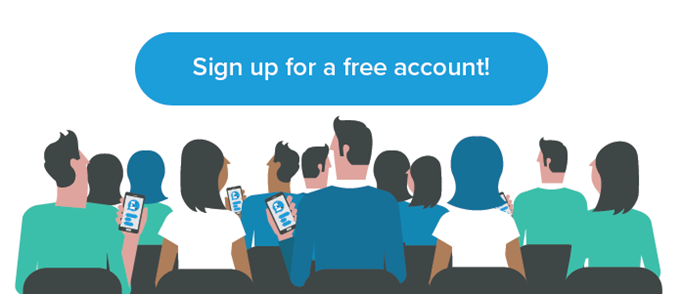The current emphasis in the pedagogic literature is that teachers should try to encourage ‘active learning’ in order to make lectures ‘unmissable’ - Race, P. (1993) Never Mind the Teaching Feel the Learning SEDA, Paper 80 (Birmingham: SEDA).
Student engagement and active learning is important for any lecture as it allows students to retain knowledge more easily and to 'experience' learning rather than being a passive spectator. Student participation increases knowledge retention and makes the experience more memorable. The Learning Pyramid (Jerome S. Bruner) shows that 50% of information is retained when conducting group discussion and 75% is retained when practicing by doing (i.e. Live Polling MCQs/tests) compared to 5% when just being lectured/talked to.
Here are our top tips to make your online and hybrid lectures more interactive and unmissable:
1. Live Polling/Interactive Quizzes
Live polls can be an effective tool to instantly engage your students and to create a buzz in a lecture that your students won’t forget. Your students can use their own mobile devices to vote on polls or answer questions that you have created which removes any fear of embarrassment if they don't know the answers. Testing your students with quizzes using live polls is a quick and easy way to enable them to reflect on the learnings throughout the lecture.
Live polls offer a great indication of what knowledge is being retained by your students and to identify knowledge gaps. When it comes to preparing students for their module exams, you can ask them to vote on the topics that they would like more time to cover in the final lectures/seminars before the exam timetable kicks in. This option definitely defines an unmissable class!
Creating a quiz with multiple choice questions (MCQs) can help you gauge student understanding and it also makes learning more fun and interactive - A win-win for both lecturer and students. Using Live multiple-choice polls heightens the learning experience as students can see what their peers are thinking and get instant feedback on their own learning by understanding what answers they got right or wrong. Students are very receptive to this style of teaching and learning as the interactivity and instant feedback creates a learning experience to remember. Read our blog about why student’s love Vevox.
2. Q&A
Encouraging students to ask questions and offering a tool that provides anonymity will increase engagement in your lectures. A tool (such as Vevox) that allows students to pose questions to the lecturer anonymously removes the barrier of embarrassment and anxiety that some students face. A Q&A format supports traditional lecturing styles by allowing students time to process information that is presented in the lecture and expand on topics that need further explanation.
A moderated Q&A app gives lecturers full control over the content that is visible to the students. Features such as Vevox’s ‘Like’ option where students up-vote each other’s questions or comments, allows them to guide the lecturer towards the most popular questions they would like to have answers to, therefore by nature creating a lecture they want to attend. Q&As can be a highly effective two-way method to increase interaction throughout the lecture and put emphasis on active student learning, allowing students some influence over the class whilst the lecturer remains in control.
3. Surveys
Self-paced surveys can be an effective tool for lecturers to gather data on the delivery and content of their modules, particularly handy for MEQ’s. However, the method of collection of this data needs to be efficient, both in the preparation by the lecturer and not too time consuming or hard to complete for the students. Allowing your students to give feedback in their own time with a digital self-paced survey means they can reflect on their thoughts and by capturing the information digitally this is easy to store and refer back to whenever needed.
To get a better response rate for your surveys, express to your students the importance of this feedback and provide them with reasons as to why they should leave feedback. Unlike live polls and other 'in the moment' data, surveys can collect data over multiple touch points and it allows students the flexibility to review and edit their answers at any given time.
4. Anonymous Feedback
Honest, uninhibited feedback can really help you understand what is working or isn't working in your lectures. At first, hearing honest and anonymous feedback from your students' might sound daunting but the data is greatly valuable to you. This data gives you a true representation of how your students feel about your lectures and allows you really to comprehend what your students are thinking. Encouraging anonymous feedback from real-time polls or messages during your lectures will ensure a higher contribution rate from your students' due to the convenience and accessibility in doing so. If you want to have great quality feedback data and to have a high rate of feedback contributions then using a quick, easy solution to leave anonymous feedback will enable you to achieve this.
5. Collaborative Learning
Peer to peer learning is a great way to include all students in the lecture and to develop interactive two-way discussions. Using a digital platform to stage these discussions can help engage students to potentially think more critically about the topics at hand. Student engagement and knowledge retention is increased if students are able to share ideas, questions and reply to each other which in turn will help to develop a community in which students feel safe to explore and share their own learnings, experiences or thoughts.
A digital platform also overcomes the physical barrier of students feeling pressurised to raise their hands to contribute (an old-fashioned and ineffective way to receive participation) or a lecturer having to choose someone to talk. Instead, allow your students to send in ideas at any given time. A digital platform or app that allows students to vote on other people's ideas is a great way to crowdsource the best ideas and to discuss the most popular topics with your students and build a great student/teacher rapport.
6. Continue the Interaction
To ensure your students are following up with your lecture materials and learnings, keep them engaged via your chosen learning environments. Use your current learning management system to ensure students are engaging with any recommended resources and share any valuable live data from quizzes and live polls with them. This way they can test themselves again with any exam style questions and remind themselves of the questions they got wrong or right.
"It is clear from this study and others that it is not just what the lecturer is or does, but what students do in the classroom that determines the degree to which lectures might be considered ‘unmissable’ " - Andrea Revell & Emma Wainwright, Centre for Human Geography, Brunel University, UK
It’s clear that active learning plays a huge part in making classes unmissable. Why not try Vevox for Free and see how live polling and Q&A can boost attendance and engagement in your lectures?





